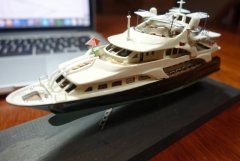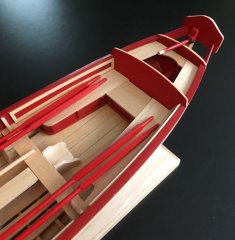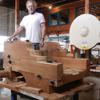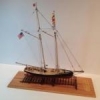-
Posts
3,353 -
Joined
-
Last visited
Reputation Activity
-
 Cathead got a reaction from FriedClams in 19th Century 31-ton Revenue Cutter by CharlieZardoz - Scale 1/64 - building as USRC Active based off Doughty plans and BlueJacket Shipcrafters kit
Cathead got a reaction from FriedClams in 19th Century 31-ton Revenue Cutter by CharlieZardoz - Scale 1/64 - building as USRC Active based off Doughty plans and BlueJacket Shipcrafters kit
Should the planks at the bow all taper up to a single point like that? My understanding was that planking lines should lie more parallel to the deck. It's a very Viking look, and a lot easier to plank that way, but I didn't think ships of this period were planked that way. You're laying out something closer to how I did the starboard side of my Ranger, but my port side is closer to how it "ought" to be in my understanding. Also, I wonder if they should taper so much; my understanding was that in traditional practice planks weren't supposed to taper more than half their original width. Of course, I'm far from an expert so am happy to be corrected. What's your thought process there?
-
 Cathead got a reaction from Omega1234 in 19th Century 31-ton Revenue Cutter by CharlieZardoz - Scale 1/64 - building as USRC Active based off Doughty plans and BlueJacket Shipcrafters kit
Cathead got a reaction from Omega1234 in 19th Century 31-ton Revenue Cutter by CharlieZardoz - Scale 1/64 - building as USRC Active based off Doughty plans and BlueJacket Shipcrafters kit
Should the planks at the bow all taper up to a single point like that? My understanding was that planking lines should lie more parallel to the deck. It's a very Viking look, and a lot easier to plank that way, but I didn't think ships of this period were planked that way. You're laying out something closer to how I did the starboard side of my Ranger, but my port side is closer to how it "ought" to be in my understanding. Also, I wonder if they should taper so much; my understanding was that in traditional practice planks weren't supposed to taper more than half their original width. Of course, I'm far from an expert so am happy to be corrected. What's your thought process there?
-
 Cathead reacted to CharlieZardoz in 19th Century 31-ton Revenue Cutter by CharlieZardoz - Scale 1/64 - building as USRC Active based off Doughty plans and BlueJacket Shipcrafters kit
Cathead reacted to CharlieZardoz in 19th Century 31-ton Revenue Cutter by CharlieZardoz - Scale 1/64 - building as USRC Active based off Doughty plans and BlueJacket Shipcrafters kit
Thank you sir! You can tell by the design these were built for speed like a dart in the water. I'm thinking of moving the drop planks/(steelers?) down by 1 however overall it looks pretty good. Mind you this hull is 8" so the detailing is smaller than it looks in the pic.
-
 Cathead reacted to CharlieZardoz in 19th Century 31-ton Revenue Cutter by CharlieZardoz - Scale 1/64 - building as USRC Active based off Doughty plans and BlueJacket Shipcrafters kit
Cathead reacted to CharlieZardoz in 19th Century 31-ton Revenue Cutter by CharlieZardoz - Scale 1/64 - building as USRC Active based off Doughty plans and BlueJacket Shipcrafters kit
And that's one side done. What does everyone think? You can see I did a few steelers and drop planks for this extreme design was necessary. Also remember the planks get thinner the closer to the deck we go and wider the further down to the keel from like 1/8" to 3/32nd". I think it looks fairly decent and flows well.
-
 Cathead reacted to CharlieZardoz in 19th Century 31-ton Revenue Cutter by CharlieZardoz - Scale 1/64 - building as USRC Active based off Doughty plans and BlueJacket Shipcrafters kit
Cathead reacted to CharlieZardoz in 19th Century 31-ton Revenue Cutter by CharlieZardoz - Scale 1/64 - building as USRC Active based off Doughty plans and BlueJacket Shipcrafters kit
Aaaaand did the planking lines as well. First started by getting the garboard plank laid out then went down from the sheer and up from the keel as so.
-
 Cathead reacted to CharlieZardoz in 19th Century 31-ton Revenue Cutter by CharlieZardoz - Scale 1/64 - building as USRC Active based off Doughty plans and BlueJacket Shipcrafters kit
Cathead reacted to CharlieZardoz in 19th Century 31-ton Revenue Cutter by CharlieZardoz - Scale 1/64 - building as USRC Active based off Doughty plans and BlueJacket Shipcrafters kit
Today I drew the deck detailing where planks, hatches, masts, windows and pivot cannon will go.
-
 Cathead reacted to CharlieZardoz in 19th Century 31-ton Revenue Cutter by CharlieZardoz - Scale 1/64 - building as USRC Active based off Doughty plans and BlueJacket Shipcrafters kit
Cathead reacted to CharlieZardoz in 19th Century 31-ton Revenue Cutter by CharlieZardoz - Scale 1/64 - building as USRC Active based off Doughty plans and BlueJacket Shipcrafters kit
And here is the side profile, fits perfectly. Little crew dude added
-
 Cathead reacted to Blue Ensign in How Realistic Can One Make Sails?
Cathead reacted to Blue Ensign in How Realistic Can One Make Sails?
You may find the answer here.
http://www.hnsa.org/resources/manuals-documents/age-of-sail/the-elements-and-practice-of-rigging-and-seamanship/sail-making-vol-i/
B.E.
-
 Cathead got a reaction from John Allen in Instructions are important to me
Cathead got a reaction from John Allen in Instructions are important to me
It's not a stupid question, just one without a clear answer because there are so many variables.
Model Expo's instructions seem to vary in quality depending on how old the kit is; the good news is that all of their kits' instructions are posted on their website, so you can review the entire process before diving in. It's a very helpful way to judge if a kit (and its instructions) are suitable. For example, Sultana has a regular set of instructions and then a long, detailed practicum (I haven't built this kit, but I've consulted its practicum before for some good drawings of certain concepts that apply to other situations).
Personally, if something like Niagara is overwhelming you, maybe look for a simpler kit? A nice sloop with one mast where you can learn the basics of rigging and then apply them to a more complex situation? I've heard very good things about BlueJacket, though I haven't built one of their kits yet.
-
 Cathead got a reaction from Ryland Craze in 18th century longboat by michaelpsutton2 - Model Shipways
Cathead got a reaction from Ryland Craze in 18th century longboat by michaelpsutton2 - Model Shipways
This is a fun kit that will teach a lot of useful basic skills. It's harder than it looks but not as hard as it seems, and as you note, there sure are a lot of good build logs to draw on. Building this really helped me learn a lot, and I wish you great success. I'll be following along.
Personally, I would use a sanding block, something that gives you a solid surface behind the sandpaper. If you try to do it with just the paper, you'll almost inevitably end up rounding off the edge rather than getting a smooth surface. I used a piece of wood that spanned about three frames at once; this also helps ensure that each frame's final angle lines up with its neighbors, ensuring a smoother run for the planks. For the planks that need a lot of fairing, you can probably use a coarser grit to save time at first. More needs to be taken off than you may think at first.
-
 Cathead got a reaction from -Dallen in Instructions are important to me
Cathead got a reaction from -Dallen in Instructions are important to me
It's not a stupid question, just one without a clear answer because there are so many variables.
Model Expo's instructions seem to vary in quality depending on how old the kit is; the good news is that all of their kits' instructions are posted on their website, so you can review the entire process before diving in. It's a very helpful way to judge if a kit (and its instructions) are suitable. For example, Sultana has a regular set of instructions and then a long, detailed practicum (I haven't built this kit, but I've consulted its practicum before for some good drawings of certain concepts that apply to other situations).
Personally, if something like Niagara is overwhelming you, maybe look for a simpler kit? A nice sloop with one mast where you can learn the basics of rigging and then apply them to a more complex situation? I've heard very good things about BlueJacket, though I haven't built one of their kits yet.
-
 Cathead got a reaction from Omega1234 in 19th Century 31-ton Revenue Cutter by CharlieZardoz - Scale 1/64 - building as USRC Active based off Doughty plans and BlueJacket Shipcrafters kit
Cathead got a reaction from Omega1234 in 19th Century 31-ton Revenue Cutter by CharlieZardoz - Scale 1/64 - building as USRC Active based off Doughty plans and BlueJacket Shipcrafters kit
Charlie, on my screen the colors are coming out really strange. I'm seeing a rainbow of colors that don't really match what you describe in your text. Did the images get corrupted somehow, or is my computer reading them strangely?
-
 Cathead got a reaction from Larry Cowden in USRC Ranger 1819 by Cathead – FINISHED – Corel – Scale 1:64
Cathead got a reaction from Larry Cowden in USRC Ranger 1819 by Cathead – FINISHED – Corel – Scale 1:64
I've been quietly working on various details, while neglecting this build log. This time of year I mostly model after dark, so photography conditions aren't very good, and as I'm also doing a lot of writing & editing work it's less attractive to spend my down time also working with words. But a month seems more than enough neglect, so here's what I've been up to.
I'm not at all happy with many of the metal castings in this kit, so decided to remake some. The cross-trees are trash; the arms aren't even square and several of the cast-in rings broke when I tried to drill them out (they were cast solid). So I made new ones from wood with brass eyerings. It took three tries to get a version I was happy with. I also didn't care for the cast anchor stocks, so again made my own. All these parts should be wood, anyway. I stained everything and wrapped the anchor stocks with blackened brass strip, touched up with paint.
I've also been working on the masts, booms, yards, and so on. Typically at this point, the diameter dowels supplied with the kit didn't fit the metal hardware, such as the various boom rings and crutches, that are supposed to fit on the masts. I had to do quite a bit of custom-sanding and filing of the metal parts to get everything right. The rings aren't even the same size, so on the mizzenmast, where two different rings are supposed to sit near one another, those two rings have very different diameters such that by the time you sand the mast down enough to make the smaller one fit, the larger one is too large. Sigh. It'll all work well enough. Overall I think these parts came out well.
Here are some detailed views of the current status. The bowsprit/jib-boom assembly is installed and gammoned, the anchors are done, the pin-racks are made, and the carronade is finished and rigged. Sharp eyes may notice that I've replaced all the blocks, everywhere, with better ones from Syren. It took a few days to work up the courage for cutting out all the blocks I'd already carefully fitted onto the various deck eyerings, but I did it and it was worth it. I'm also happy with how the rope coils turned out for the carronade and anchor lines. The light in these last few photos is still a little odd; I took it outdoors late in the afternoon, and the white background produced an odd color balance. Oh well.
I should mention a few mistakes made along the way. I rigged the whole carronade assembly off the model, then installed it, tying the outer-four blocks to their respective eyerings (pre-glued into the deck). Only after completion did I notice that I'd rigged the port side backwards; the forward tackle is supposed to go over the aftward tackle on both sides, but I'd done the it the wrong way on the port side. Much cursing ensued, as the gun was already glued down and I didn't think I could re-rig it in place because of tight clearances. Finally I used a pair of small pliers to work the whole eyebolt out of the deck, slid the entire tackle assembly out from under the rear tackle, and re-inserted the eyering once the rest of the tackle was on top. I don't know if anyone could follow that, but in the photo above it's now rigged properly.
I also managed to glue the crosstrees onto the masts backwards the first time, but managed to get them off without breaking anything. Then I filed away the glue and re-installed them properly. Only then did I realize that I should have tied on all the blocks to the rings beforehand; now I have to do it up on top the masts. Oh well, that I can handle. I'll put equal blame on me for not thinking far enough ahead, and the instructions for being nearly completely useless.
And here she is now, with an insert showing one of the hand-made crosstrees (as luck would have it, the less-good one which I didn't notice through the lens). The masts are glued in, with the proper rake established using a cardboard pattern traced from the plans and various temporary rigging lines. It's amazing what a few dowels can do to transform a hull into a ship. Of course, I now have to be extra-careful because I've gotten used to reaching around and over the hull to grab something, and now there are delicate bits sticking up into my arm-space.
So that's how this revenue cutter enters the New Year. I'm about to have to start deciphering rigging diagrams, something that is equally fascinating and terrifying to me. Because I want to rig this model with sails, I may start with those first. Thanks for reading and for all your support in this very educational project. Happy New Year!
-
 Cathead got a reaction from CharlieZardoz in 19th Century 31-ton Revenue Cutter by CharlieZardoz - Scale 1/64 - building as USRC Active based off Doughty plans and BlueJacket Shipcrafters kit
Cathead got a reaction from CharlieZardoz in 19th Century 31-ton Revenue Cutter by CharlieZardoz - Scale 1/64 - building as USRC Active based off Doughty plans and BlueJacket Shipcrafters kit
Charlie, on my screen the colors are coming out really strange. I'm seeing a rainbow of colors that don't really match what you describe in your text. Did the images get corrupted somehow, or is my computer reading them strangely?
-
 Cathead got a reaction from Tigersteve in 18th century longboat by michaelpsutton2 - Model Shipways
Cathead got a reaction from Tigersteve in 18th century longboat by michaelpsutton2 - Model Shipways
This is a fun kit that will teach a lot of useful basic skills. It's harder than it looks but not as hard as it seems, and as you note, there sure are a lot of good build logs to draw on. Building this really helped me learn a lot, and I wish you great success. I'll be following along.
Personally, I would use a sanding block, something that gives you a solid surface behind the sandpaper. If you try to do it with just the paper, you'll almost inevitably end up rounding off the edge rather than getting a smooth surface. I used a piece of wood that spanned about three frames at once; this also helps ensure that each frame's final angle lines up with its neighbors, ensuring a smoother run for the planks. For the planks that need a lot of fairing, you can probably use a coarser grit to save time at first. More needs to be taken off than you may think at first.
-
 Cathead got a reaction from mtaylor in 19th Century 31-ton Revenue Cutter by CharlieZardoz - Scale 1/64 - building as USRC Active based off Doughty plans and BlueJacket Shipcrafters kit
Cathead got a reaction from mtaylor in 19th Century 31-ton Revenue Cutter by CharlieZardoz - Scale 1/64 - building as USRC Active based off Doughty plans and BlueJacket Shipcrafters kit
Charlie, on my screen the colors are coming out really strange. I'm seeing a rainbow of colors that don't really match what you describe in your text. Did the images get corrupted somehow, or is my computer reading them strangely?
-
 Cathead reacted to CharlieZardoz in 19th Century 31-ton Revenue Cutter by CharlieZardoz - Scale 1/64 - building as USRC Active based off Doughty plans and BlueJacket Shipcrafters kit
Cathead reacted to CharlieZardoz in 19th Century 31-ton Revenue Cutter by CharlieZardoz - Scale 1/64 - building as USRC Active based off Doughty plans and BlueJacket Shipcrafters kit
Type III: standard wale
In this version the wale does not change color, instead the sheer and lower hull and stripe communicate design. It's more suttle and perhaps more European in it's display of coloring however I've seen a model of Artesania Latina's Dallas done like #16 so it could work as well, though not quite my favorite.
So that's the idea, the next step will be to do a mock plank job and see how they look, feedback is welcomed and see ya all next year ya salty sea dogs, arggh!!!
-
 Cathead reacted to CharlieZardoz in 19th Century 31-ton Revenue Cutter by CharlieZardoz - Scale 1/64 - building as USRC Active based off Doughty plans and BlueJacket Shipcrafters kit
Cathead reacted to CharlieZardoz in 19th Century 31-ton Revenue Cutter by CharlieZardoz - Scale 1/64 - building as USRC Active based off Doughty plans and BlueJacket Shipcrafters kit
Type II: the workhorse
This design has a lot of exposed wood up top by the sheer and the design is to denote usefulness over style. The wooden areas wouldn't be painted since the area would be constantly in use. It still has a changing wale and the cap rail is black but can also be wood (chose a lighter wood to contrast see #12) with some variations as shown. This would allow more of the models wood to be exposed and appreciated aesthetically but could also be too complex.
-
 Cathead reacted to CharlieZardoz in 19th Century 31-ton Revenue Cutter by CharlieZardoz - Scale 1/64 - building as USRC Active based off Doughty plans and BlueJacket Shipcrafters kit
Cathead reacted to CharlieZardoz in 19th Century 31-ton Revenue Cutter by CharlieZardoz - Scale 1/64 - building as USRC Active based off Doughty plans and BlueJacket Shipcrafters kit
Greetings everyone! So I spent the good part of a day really working through the color patterns possible for these simple ships and anyone who's been following my other post of ship colors knows this has been eating at me. But I believe I've come to 3 main plausible color variation types so without further adieu here they are!
Type I: Flashy
This design for me looks the most upscale. Most of the hull is painted in black, the sheer and hull areas don't change. Color changes via the wale and stripe above the wale. The 31 ton has a tarred brown basic wale, the 51 uses copper/green and white, then the 80 ton uses ochre and a red strip. Cap rails are white though they could also be wood finish (see #6) or black. I like white/tallow since it gives the 31 and 52 two stripes like clippers and other revenue cutter images ive seen. There is a gradual increase in color complexity from 1 to 2 to 3 colors to denote class and importance of the ship assuming the larger ships had more prominent functions and could be identified by commanders. I overall really like this design though it may be a bit on the flashy side, it follows Pride of Baltimore II the model of Achilles, Swift and other revenue cutter images which seem to have 2 white or tallow stripes so this design does has a reference point.
-
 Cathead got a reaction from mattsayers148 in USRC Ranger 1819 by Cathead – FINISHED – Corel – Scale 1:64
Cathead got a reaction from mattsayers148 in USRC Ranger 1819 by Cathead – FINISHED – Corel – Scale 1:64
I've been quietly working on various details, while neglecting this build log. This time of year I mostly model after dark, so photography conditions aren't very good, and as I'm also doing a lot of writing & editing work it's less attractive to spend my down time also working with words. But a month seems more than enough neglect, so here's what I've been up to.
I'm not at all happy with many of the metal castings in this kit, so decided to remake some. The cross-trees are trash; the arms aren't even square and several of the cast-in rings broke when I tried to drill them out (they were cast solid). So I made new ones from wood with brass eyerings. It took three tries to get a version I was happy with. I also didn't care for the cast anchor stocks, so again made my own. All these parts should be wood, anyway. I stained everything and wrapped the anchor stocks with blackened brass strip, touched up with paint.
I've also been working on the masts, booms, yards, and so on. Typically at this point, the diameter dowels supplied with the kit didn't fit the metal hardware, such as the various boom rings and crutches, that are supposed to fit on the masts. I had to do quite a bit of custom-sanding and filing of the metal parts to get everything right. The rings aren't even the same size, so on the mizzenmast, where two different rings are supposed to sit near one another, those two rings have very different diameters such that by the time you sand the mast down enough to make the smaller one fit, the larger one is too large. Sigh. It'll all work well enough. Overall I think these parts came out well.
Here are some detailed views of the current status. The bowsprit/jib-boom assembly is installed and gammoned, the anchors are done, the pin-racks are made, and the carronade is finished and rigged. Sharp eyes may notice that I've replaced all the blocks, everywhere, with better ones from Syren. It took a few days to work up the courage for cutting out all the blocks I'd already carefully fitted onto the various deck eyerings, but I did it and it was worth it. I'm also happy with how the rope coils turned out for the carronade and anchor lines. The light in these last few photos is still a little odd; I took it outdoors late in the afternoon, and the white background produced an odd color balance. Oh well.
I should mention a few mistakes made along the way. I rigged the whole carronade assembly off the model, then installed it, tying the outer-four blocks to their respective eyerings (pre-glued into the deck). Only after completion did I notice that I'd rigged the port side backwards; the forward tackle is supposed to go over the aftward tackle on both sides, but I'd done the it the wrong way on the port side. Much cursing ensued, as the gun was already glued down and I didn't think I could re-rig it in place because of tight clearances. Finally I used a pair of small pliers to work the whole eyebolt out of the deck, slid the entire tackle assembly out from under the rear tackle, and re-inserted the eyering once the rest of the tackle was on top. I don't know if anyone could follow that, but in the photo above it's now rigged properly.
I also managed to glue the crosstrees onto the masts backwards the first time, but managed to get them off without breaking anything. Then I filed away the glue and re-installed them properly. Only then did I realize that I should have tied on all the blocks to the rings beforehand; now I have to do it up on top the masts. Oh well, that I can handle. I'll put equal blame on me for not thinking far enough ahead, and the instructions for being nearly completely useless.
And here she is now, with an insert showing one of the hand-made crosstrees (as luck would have it, the less-good one which I didn't notice through the lens). The masts are glued in, with the proper rake established using a cardboard pattern traced from the plans and various temporary rigging lines. It's amazing what a few dowels can do to transform a hull into a ship. Of course, I now have to be extra-careful because I've gotten used to reaching around and over the hull to grab something, and now there are delicate bits sticking up into my arm-space.
So that's how this revenue cutter enters the New Year. I'm about to have to start deciphering rigging diagrams, something that is equally fascinating and terrifying to me. Because I want to rig this model with sails, I may start with those first. Thanks for reading and for all your support in this very educational project. Happy New Year!
-
 Cathead got a reaction from ggrieco in USRC Ranger 1819 by Cathead – FINISHED – Corel – Scale 1:64
Cathead got a reaction from ggrieco in USRC Ranger 1819 by Cathead – FINISHED – Corel – Scale 1:64
I've been quietly working on various details, while neglecting this build log. This time of year I mostly model after dark, so photography conditions aren't very good, and as I'm also doing a lot of writing & editing work it's less attractive to spend my down time also working with words. But a month seems more than enough neglect, so here's what I've been up to.
I'm not at all happy with many of the metal castings in this kit, so decided to remake some. The cross-trees are trash; the arms aren't even square and several of the cast-in rings broke when I tried to drill them out (they were cast solid). So I made new ones from wood with brass eyerings. It took three tries to get a version I was happy with. I also didn't care for the cast anchor stocks, so again made my own. All these parts should be wood, anyway. I stained everything and wrapped the anchor stocks with blackened brass strip, touched up with paint.
I've also been working on the masts, booms, yards, and so on. Typically at this point, the diameter dowels supplied with the kit didn't fit the metal hardware, such as the various boom rings and crutches, that are supposed to fit on the masts. I had to do quite a bit of custom-sanding and filing of the metal parts to get everything right. The rings aren't even the same size, so on the mizzenmast, where two different rings are supposed to sit near one another, those two rings have very different diameters such that by the time you sand the mast down enough to make the smaller one fit, the larger one is too large. Sigh. It'll all work well enough. Overall I think these parts came out well.
Here are some detailed views of the current status. The bowsprit/jib-boom assembly is installed and gammoned, the anchors are done, the pin-racks are made, and the carronade is finished and rigged. Sharp eyes may notice that I've replaced all the blocks, everywhere, with better ones from Syren. It took a few days to work up the courage for cutting out all the blocks I'd already carefully fitted onto the various deck eyerings, but I did it and it was worth it. I'm also happy with how the rope coils turned out for the carronade and anchor lines. The light in these last few photos is still a little odd; I took it outdoors late in the afternoon, and the white background produced an odd color balance. Oh well.
I should mention a few mistakes made along the way. I rigged the whole carronade assembly off the model, then installed it, tying the outer-four blocks to their respective eyerings (pre-glued into the deck). Only after completion did I notice that I'd rigged the port side backwards; the forward tackle is supposed to go over the aftward tackle on both sides, but I'd done the it the wrong way on the port side. Much cursing ensued, as the gun was already glued down and I didn't think I could re-rig it in place because of tight clearances. Finally I used a pair of small pliers to work the whole eyebolt out of the deck, slid the entire tackle assembly out from under the rear tackle, and re-inserted the eyering once the rest of the tackle was on top. I don't know if anyone could follow that, but in the photo above it's now rigged properly.
I also managed to glue the crosstrees onto the masts backwards the first time, but managed to get them off without breaking anything. Then I filed away the glue and re-installed them properly. Only then did I realize that I should have tied on all the blocks to the rings beforehand; now I have to do it up on top the masts. Oh well, that I can handle. I'll put equal blame on me for not thinking far enough ahead, and the instructions for being nearly completely useless.
And here she is now, with an insert showing one of the hand-made crosstrees (as luck would have it, the less-good one which I didn't notice through the lens). The masts are glued in, with the proper rake established using a cardboard pattern traced from the plans and various temporary rigging lines. It's amazing what a few dowels can do to transform a hull into a ship. Of course, I now have to be extra-careful because I've gotten used to reaching around and over the hull to grab something, and now there are delicate bits sticking up into my arm-space.
So that's how this revenue cutter enters the New Year. I'm about to have to start deciphering rigging diagrams, something that is equally fascinating and terrifying to me. Because I want to rig this model with sails, I may start with those first. Thanks for reading and for all your support in this very educational project. Happy New Year!
-
 Cathead reacted to CharlieZardoz in 19th Century 31-ton Revenue Cutter by CharlieZardoz - Scale 1/64 - building as USRC Active based off Doughty plans and BlueJacket Shipcrafters kit
Cathead reacted to CharlieZardoz in 19th Century 31-ton Revenue Cutter by CharlieZardoz - Scale 1/64 - building as USRC Active based off Doughty plans and BlueJacket Shipcrafters kit
Then I redrew all the lines. So aside from some minor shaping I plan on doing by the transom, the hull shaping is essentially done for the 31 pounder anyways. Note the lovely curve at the edge of the hull which curves slightly upwards at the bow and stern and note the pencil line on the bowsprit where the deck is supposed to line up. Next up is going to be the beginnings of adding planking lines in preparation for the planking. Crew added for dramatic effect, that guy in the front though... "metaaaaahhllll!!"
-
 Cathead reacted to CharlieZardoz in 19th Century 31-ton Revenue Cutter by CharlieZardoz - Scale 1/64 - building as USRC Active based off Doughty plans and BlueJacket Shipcrafters kit
Cathead reacted to CharlieZardoz in 19th Century 31-ton Revenue Cutter by CharlieZardoz - Scale 1/64 - building as USRC Active based off Doughty plans and BlueJacket Shipcrafters kit
Thanks Mark! And here we have the same approach to the bow. Took a small piece, sanded it down and glued it on removing the excess then sanding and filling. You can see the areas where lighter wood filler was used before I used the finishing filler in natural color. Everything was then polished with a fine sandpaper.
-
 Cathead reacted to Tigersteve in 18th Century Longboat by Tigersteve - FINISHED - Model Shipways
Cathead reacted to Tigersteve in 18th Century Longboat by Tigersteve - FINISHED - Model Shipways
Windlass and handles are complete. I drew reference lines and that helped while filing the shape. This part was enjoyable to make. You'll notice an extra windlass I did freedhand now scrap. I completed the horse. It was difficult to get the wire straight. One of my drill bits broke so no oarlocks for now.
Steve
-
 Cathead got a reaction from _SalD_ in Corel Venetian Galleon Ship (Galeone Veneto) - kit recommendation
Cathead got a reaction from _SalD_ in Corel Venetian Galleon Ship (Galeone Veneto) - kit recommendation
I am building the Corel Ranger right now, and will never build another kit from them.












